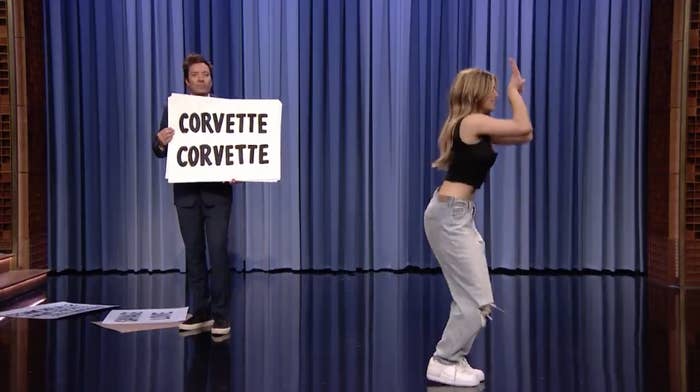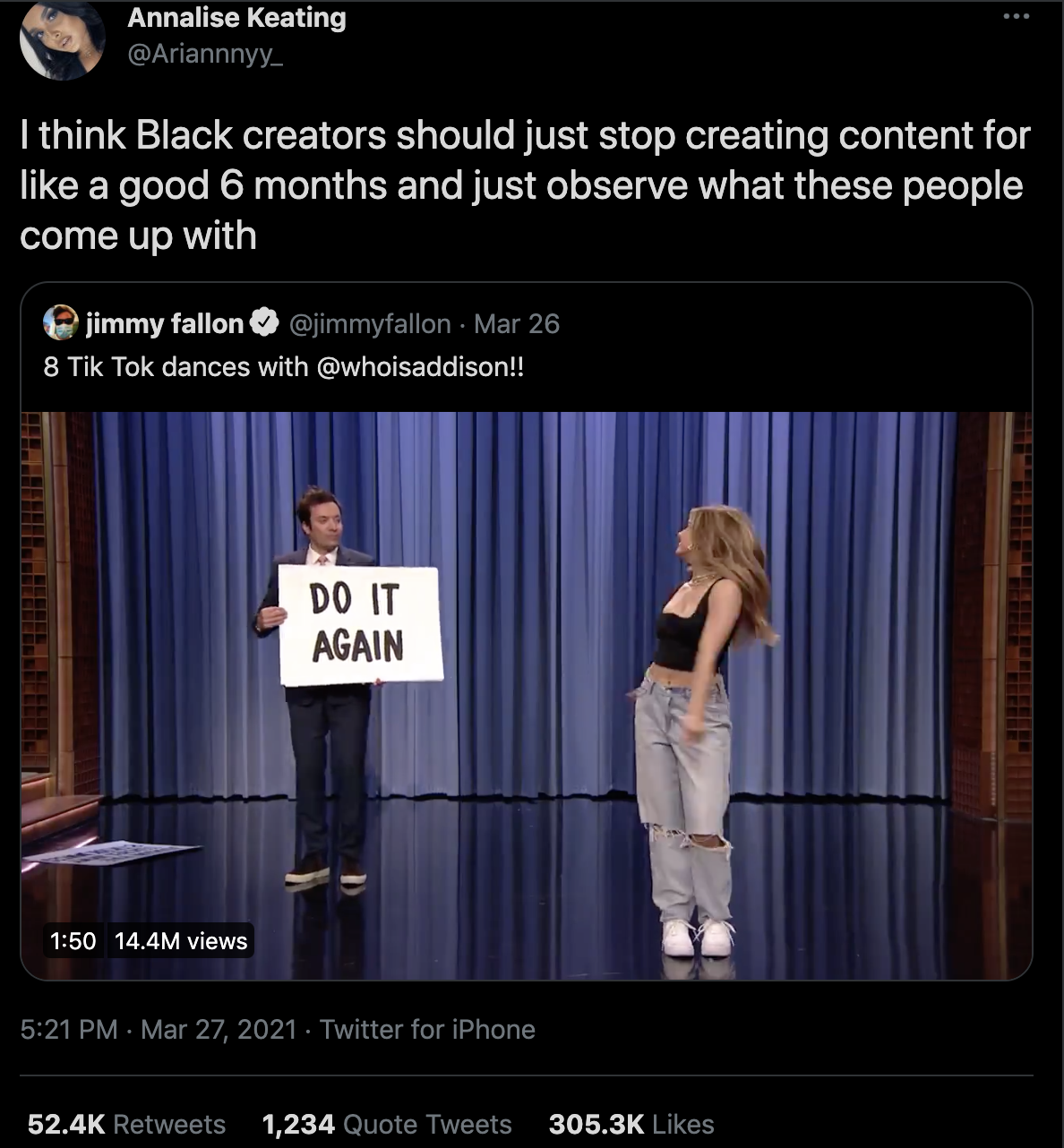This is an excerpt from Please Like Me, BuzzFeed News’ newsletter about how influencers are battling for your attention. You can sign up here.
TikTok dances are a symbol of a fight for opportunity

The best way I can describe the video of Jimmy Fallon standing behind Addison Rae as she gives a pageantry performance of TikTok dance crazes to a strange Tonight Show band cover medley of the songs is discomforting. Over the weekend, as the clip went viral on Twitter, others seemed to feel the same.
Rae, the second-most-followed person on TikTok, appeared as a special guest on Friday’s episode of The Tonight Show Starring Jimmy Fallon. She performed eight popular “TikTok dances,” and she and Fallon danced together at the end of the medley. If this segment existed in a vacuum, it’d be a weird, cute clip at best. The dances are cute, she performed them OK, the production is still very awkward.
But because both Rae and Fallon have massive influence in this country, this clip had meaning that made me and others uncomfortable for far bigger reasons than its production value. Rae had been chosen to appear on a national stage performing choreography created by lesser-known TikTokers who often are BIPOC. I tweeted about this, and my tweet and many other responses went more viral than the clip itself.
Producers for The Tonight Show, which averages millions of viewers, picked Rae to be the representative of these dances. Since, I presume, a vast majority of American Tonight Show viewers are not well versed with TikTok culture, it’s likely they will now connect the 20-year-old to the origin of these dance crazes.
“So I’m guessing all of the black creators who made these dances up were busy huh?” user @KoolestKidOut tweeted.

Not all of the creators of the eight dances are Black, but many of them are. In fact, a majority of the dances that trend on the app are created by both professional and amateur Black dancers. The choreographers of the dances featured in the medley are @noahschnapp (“Do It Again”), @jazlynebaybee (“Savage Love”), @yvnggprince (“Corvette Corvette”), @flyboyfu (“Laffy Taffy”), @keke.janajah (“Savage”), @macdaddyz (“Blinding Lights”), @theemyanicole (“Up”), and @thegilberttwins (“Fergalicious”).
On Wednesday, Rae responded to the criticisms of her Tonight Show appearance by saying she loves the original creators “so much” and supports “all of them so much.”
“I definitely want to collaborate with a lot of them. They definitely deserve all the credit because they came up with the amazing trends,” she added.
Before you dismiss that a 30- or 60-second dance doesn’t merit this level of controversy, consider a few things. First, how much money is involved in viral ventures, and how many career and branding opportunities there are for creators online. Rae is a living embodiment of this lucrative economy! She is who she is because of all her pursuits and all the business opportunities she’s been given, ironically, off the work and backs of Black and brown creators pursuing the same things.
Second, a quick dance sequence is not as easy as it looks. I reached out to several Black TikTokers last year for a story when the crediting controversy reached a tipping point on the app. I learned that internet dances have become a burgeoning subculture of the dance community, especially coming out of the Atlanta area. Dancers like Bryan Sanon and Zach Jelks told me they have dedicated their entire careers to coming up with moves they know will hit a mass market online, and it requires a special kind of creativity and strategy. (It’s also why an average person, or a disgruntled troll, could not develop, perform, or market choreography with the same level of success. And if you are a disgruntled troll who wants to discount this issue, I challenge you to prove me wrong.)
Sanon also told me it’s become an unspoken rule that Black dancers give each other credit when they perform each other’s dances on social media. It’s why it’s become extra frustrating to not see everyone else engage in these best practices on TikTok.
In June 2020, Black creators demanded that some of the platform’s most popular white influencers doing their dances give them basic recognition. Some of them did: Charli D’Amelio and Addison Rae learned to include dancer credits in their own TikToks. A quick tag, or a mention, can drive droves of new followers to their accounts.
While the acknowledgment and active support of lesser-known BIPOC creators is a fundamental step in trying to leverage opportunities, it’s an entire system that we have all bought into that continues to elevate the Charli D’Amelios and Addison Raes. The Charlis and the Addisons have been born into more privilege, and their families could afford for them to pursue this lucrative new kind of showbiz. They have the desired looks and personality traits. Fans were instantly drawn to them. The more popular they became, the more corporate America wanted to invest, and the more astronomically popular they would grow. That’s why, when Tonight Show writers and producers conceived of a TikTok segment, they turned to the most visible and one of the most followed dancers on the app.
To fracture this system and create more equity, someone or multiple people in this chain need to start valuing different things. A fan could reconsider or redistribute their support; an influencer could not only share their spotlight, but lend it entirely to someone else; media outlets like ours can reexamine how we cover influencers; and other big TV and commercial industries can reallocate their investments.
It’s a tricky terrain and infrastructure that’s hundreds of years in the making in this country. It would be fantasy to think that changes can be made overnight — and perhaps they shouldn’t be. This system and the many American industries involved in it depend on each other to survive. There is a lot of money involved. When I cover influencers, even in criticism, I ask myself how much my coverage is fracturing the system and how much more opportunity and attention I could unintentionally be giving them. I don’t know, and I welcome your thoughts. But I do know that ignoring the issue altogether is not only unhelpful but arguably how we got to this point.
Also, as someone who spent her early pandemic life trying to learn these TikTok dances: They are more challenging than you might think.
—Tanya Chen
“Girl, Don’t Call Me Relatable!” —Rachel Hollis
Rachel Hollis, toxic positivity enthusiast and Instagram self-help queen, on Wednesday released a TikTok rant that has a lot of people saying... What the F?
In the TikTok, Hollis begins by complaining that a commenter called her privileged after Hollis mentioned in an Instagram Live that a woman comes and “cleans her toilets” twice a week. Hollis admits her privilege, but says that she “works her ass off” for the money she has.
In a second comment, the woman called Hollis unrelatable, which Hollis says really grinded her gears.
“What is it about me that made you think I want to be relatable?” Hollis says. “No, sis, literally everything I do in my life is to live a life that most people can’t relate to. Most people won’t work this hard. Most people won’t get up at 4 a.m. Most people won’t fail publicly again and again just to reach the top of the mountain. Literally every woman I admire in history was unrelatable. If my life is relatable to most people, I’m doing it wrong.”
In the caption of the video, which she cross-posted to Instagram, Hollis lists the women in history she admires who she thinks are also “unrelatable.”
“Harriet Tubman, RBG, Marie Curie, Oprah Winfrey, Amelia Earhart, Frida Khalo, Malala Yousafzai, Wu Zetian... all Unrelatable AF.”
The rant is pretty consistent with Hollis’s usual message: that the only reason women are not reaching their full potential is their own lack of imagination and drive. But this video hit a nerve, particularly because, as some people read it, Hollis seemed to be literally comparing herself to Harriet Tubman, among other feminist icons.
Of course we can quibble about whether Hollis is actually saying she is on the same level as these women, or rather if she is just saying they are her role models. (She didn’t return a request for comment to clarify what she meant.)
But people were still pissed and confused, especially since Hollis has a history of plagiarizing Black civil rights leaders.
“Its fine if she wants to pay someone to clean her house, but did she really just compare herself to Harriet Tubman?! 😂” commented one person.
“Malala was SHOT on the bus by Taliban for going to school. What does this have to do with your little relatability fight on the internet? This is appaling to me,” wrote another.
People also found the rant odd, as Hollis has built her brand on being a relatable figure to her audience, a girlfriend you can rely on to encourage you to be your best self.
“I guess we thought you were relatable because that the message you’ve been sending everyone for years. The ‘I’m just like you,’” one commenter noted.
In watching this video, I do wonder if Hollis’s empire is starting to, not crumble exactly, but shake a bit. She’s had a tough past year. After she and her ex-husband, Dave, with whom she hosted couples help conferences, split last year, they faced criticism for selling themselves as relationship experts and being fake. Hollis’s latest book, Didn’t See That Coming, was finished before the split and updated to include both that and some reflection on the COVID-19 pandemic. It was on the New York Times bestseller list for about six weeks, but failed to match the runaway success of her first book, Girl, Wash Your Face, which spent more than a year on the list, and its sequel, Girl, Stop Apologizing, which spent more than six months there. The comparatively tepid response to Didn’t See That Coming makes me wonder if her fandom is waning.
I also see a bit of a change in Hollis herself. While her message is similar, her delivery is sharper and more rattled than it used to be, making me wonder if her veneer of “your best friend Rach” is starting to crack a bit. Or maybe she just had a bad day. Girl, what do I know?
—Stephanie McNeal

